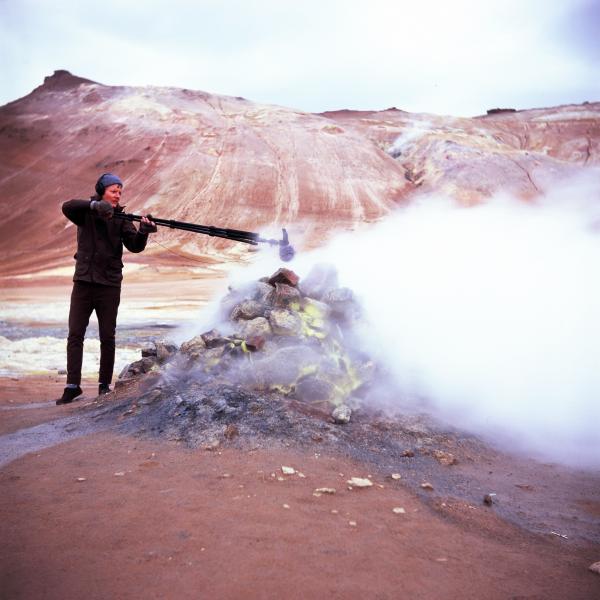Acoustic + Epistemology = Acoustemology
“As place is sensed, senses are placed; as places make sense, senses make place.”—Steven Feld
LACMA’s Art + Technology Lab is pleased to present a special audio mix by 2017 LACMA Art + Technology Lab grant recipient Curtis Tamm. As part of his project, Tympanic Tether, the artist conducted audio visual fieldwork in geologically active parts of the world to re-evaluate the relationship between culture and natural catastrophes. Traveling to Santorini, Greece, Yellowstone National Park in the U.S., East Iceland, and multiple locations in Japan, he researched the experiential and technological origins of the siren as a warning device and developed a series of new “siren candidates.” Far from typical sirens, the sounds in the mix aim to heal trauma. Instead of a shrill wail, think of resonating temple bells, the visceral bubbling of thermal mud pots, and the distant calls of wildlife across Yellowstone’s vast Central Plateau.
We sat down with Tamm to talk about his research and travels and learn why it may be worth rethinking the role of the aural warning siren in our lives today.
Tell us about your siren candidates. What are they inspired by? How do they differ from our current use and (western) understanding of the siren?
In 2015 I was invited to participate in a symposium on the Greek island of Santorini. The event was organized by the Santozeum and PS1: Fluid States, bringing scholars and artists together to think about sound and catastrophe in new ways. The island is an ear-shaped caldera with a smaller volcanic crater in its center, which is steadily emerging as lava piles up out of the Aegean Sea. Santorini was settled by the Minoans between 1750 and 1500 BCE, but life on the island came to an abrupt end in one of the largest volcanic eruptions on geologic record. Plato described it as the fall of Atlantis; that mythic society blindsided by greed and so invested in technological advancement it angered the gods, bringing divine wrath upon the island in the form of a cataclysmic pyroclastic flow. The fast-moving plumes of searing hot gas and tephra instantaneously preserved the Minoan settlement, suspending their dynamic cultural heritage within a solidified cloud of pumice. I spent a lot of time wandering around the archaeological site in Akrotiri—a prehistoric village on the southern end of the caldera’s earlobe, where the full extent of the devastation can be seen. What’s intriguing and mysterious about the excavation site is that no human remains have been unearthed there. So, the Minoans must have left before the eruption, but to coordinate such an immense evacuation effort involving thousands fleeing the island by small boat—to have established a civilization on the precipice of an active volcano in the first place, no doubt requires the cultivation of a profound sense of rhythm, collaboration, and an attentive practice of listening. Questions began to surface: What was their aural warning siren? What calls and responses echoed between “Minoan” and “caldera” which signaled it was finally time to uproot and leave everything behind? What was this proto-volcanology they possessed? And how might living on the edge of such an unpredictable energy source capacitate improvisational agility? I became inspired by these speculative sensitivities, and have since been working with the concept of redesigning aural warnings, by developing a library of new siren candidates which quarry the human body for latent attention practices, buried beneath the noise of our urban-industrial complex.
What role does mythology play?
From a long way off, sirens are hauntingly beautiful; those wavelike tones reverberating off distant concrete and glass and metal populate the city with a choir of surreal agents. But I’m weary of the seductive archetype their namesake invokes, and wonder what other mythic residues are still being carried unnoticed, enchained within their now hyper-politicized song. Historically and mythically, sirens have been a progenitor of death not life, and a death one is lured into accepting without resistance. Sirens possess an ambiguous and paradoxical authority over us, simultaneously attracting and repelling our attention. At close range their dissonance can be downright painful, cutting us off from our own thoughts and surroundings, which seems a bit counterintuitive for a symbol of civic safety. There’s also been a lack of melodic development; a simple sine wave sweeping through our ears’ primary frequency response, left relatively unchanged since industrialization of the 1800s. But like much of urban life, we simply endure it. Even if research tells us sirens quicken our heart, make us perspire, plugging our ears to peel away from the electric and pneumatic vacuum of those sinusoidally punitive pure tones.
Surely, aural warnings are wildly important for our cities, especially those of our local fire brigades, ambulances, and police vehicles, obviously. But, whether or not these tones should be invoking the musical archetype which lures us willingly into death, is a sound design challenge and an epistemological puzzle worth taking seriously.
For the past few years you've led a fairly peripatetic existence that seems to closely mesh with your research and artwork. How have your travels and fieldwork shaped your practice?
It’s easy to become disillusioned by all the unpredictable events and mini catastrophes which unfold once a project is underway. Improvised fieldwork has been a way for me to re-evaluate the conventional definition of what constitutes an “accident.” This has been helpful in finding ways to carry on with my creative endeavors, to maintain energy for them and not just curl up on the floor in the fetal position when something doesn’t go as planned. It’s been a process of learning how to integrate and make use of mistakes. A way of composting accidents into shapes beyond systematic thinking, keeping in check any unnecessary and self-aggrandizing expectations for a project, which can often lurk in the subconscious. Accidents populate artworks with an uncanny agency, transforming “mistakes” into lures, leading us toward strange and unpredictable perspectives. Considering who or what is making the lure dance creates renewable energy for the process. This isn’t always enjoyable, or what is initially desired, but I prefer it this way. There are times when making can become turbulent and frightening, like allowing a stranger into your home and just seeing what happens. Often they make a mess in the pantry, but in the process of cleaning it all up something invaluable is learned.
Miles Davis says “if you play it once it’s a mistake, if you play it twice it’s Jazz.” Musical and performative improvisation has been an important part of my life, but in 2014 when I began traveling and making work the concept took on new significance. Improvisation became a way of thinking and feeling and building relationships with others, a way of finding alternative sources of income, as well as practicing research and developing projects. Not being in a place for longer than two or three months created a frenzy in day-to-day existence, which began to leech into my core. Now it’s clear my fascination with the productive value of non-sense and disorientation emerged out of the necessity to develop a coping strategy for living well with uncertainty. Heraclitus says “the most beautiful world is a heap of rubble tossed down in confusion.” I’m finally beginning to understand what he’s getting at; at a certain scale, catastrophe is the carpenter of the planet's rhythms, and life itself is born and held in the teeth of toiling cataclysmic change. This is an old story. Be they personal or global, catastrophic events inoculate reality with a greater sensitivity to deep time. And the disorientation which results from those “sudden turns” create doorways into the dynamic and dissipative structures shaping our worlds, and even our bodies—which have always been a collection of improvised micro-communities and mini-disasters, structured together like lines of catastrophic poetry.
Pauline Oliveros once said “I am hard of hearing, but not hard of listening.” Hearing is an act we do with our ears, but listening as she described it, is more of an attention practice of the organism as a whole. It’s a way of encountering uncertainty with a warrior’s focus, enduring disorientation without becoming overwhelmed and panicked; to just watch the dye being stirred and let it settle. At times, a productive ambiguity presents itself. When listening deeply the differences between our being and the voice of our subjectivity is amplified to a bleeding edge. The two become unfused—distinct entities. Deep listening makes “being” feel far older and queerer than subjectivity; something pre-subjective and not distinctly human.
Fieldwork in landscapes with catastrophic potential has been a critical training ground to enact and test the tensile strength of these ideas in pragmatic and perceptual ways. Last October I was in Yellowstone, hiking and gathering sounds in the backcountry along a fissure swarm, and stumbled upon a group of geologists way off trail. It was a humorous interaction; at first the group thought I was a grizzly emerging from the tree line, and were all armed and ready with their bear spray, shouting and clapping at the unseen beast rifling toward them through the trees. But then I emerged, all wrapped up in quarter-inch cables and infrasonic microphones. Being so far away from civilization and encountering other people, especially when in a state of hyper-focus can feel like a harsh come down. Like having to relearn how to talk and think again in terms a human can understand. The geologists were analyzing gases bubbling forth from a series of pools and vents, and I was there listening to the visceral, digestive noises these gases make as they break through the viscous mineral-rich clay. The geologists mentioned that the gasses were as old as the Earth itself; we realized too that the sounds percolating up and frothing forth from these primordial mouths must be just as ancient. It’s hard to wrap your guts around the idea, but depth is memory. Be it for distant starlight, the earth, or our own bodies. Deep listening is one way of distending consciousness into deep time. It really is possible to think in time scales beyond our own individual lifespan, it's just a matter of enduring the disorientation of becoming something other than human along the way.
Stay tuned for Part 2 of our conversation with Curtis Tamm.
The Art + Technology Lab is presented by

The Art + Technology Lab is made possible by Accenture, YouTube Learning, and Snap Inc.
Additional support is provided by SpaceX.
The Lab is part of The Hyundai Project: Art + Technology at LACMA, a joint initiative exploring the convergence of art and technology.
Seed funding for the development of the Art + Technology Lab was provided by the Los Angeles County Quality and Productivity Commission through the Productivity Investment Fund and LACMA Trustee David Bohnett.



